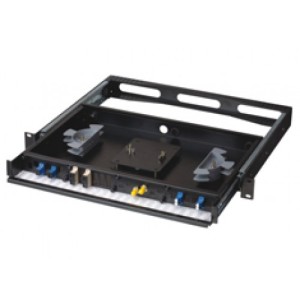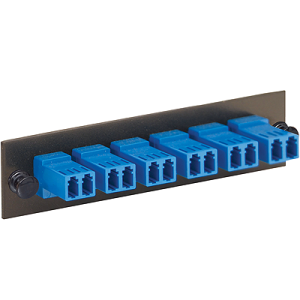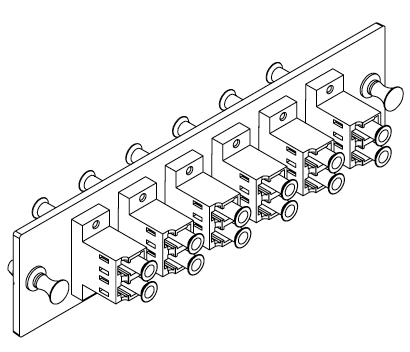

Share Various Fiber Optic Telecom Network Topics, Information, News, Questions, Sources and Network Solutions.







When surmounting trouble rises, a fiber optic technician must choose the most suitable patch panel for a specific situation. He has to understand that when it comes to easy installation, proper termination and long-term maintenance, its not all patch panel is made equally.
Optical fiber is robust and thus deserves some kind of special treatment. For example, if your horizontal copper cable is broken, one user is about be affected. If your backbone fiber goes down, it will grab a lot of users down by using it. For this reason using fully enclosed connecting hardware for optical fiber is essential. This is where the technician must choose between using wall-mounted or rack-mounted hardware. The optical fiber density required will likely influence the technicians choice between the wall-mounted and rack-mounted connectivity. Many technicians will choose to use fiber patch cables. However, how to handle the fiber patch cables?
What is Fiber Adapter Panel?
Fiber Adapter Panel (FAP) is utilized for patching the fiber cable to the enclosures like fiber wall cabinets, rack mounts fiber cabinets or rack mount fiber shelf. It enables you to make fast and simple fiber patch panel connections as they can snap into the fiber optic enclosures easily.

Fiber Adapter Panel provided by Fiberstore:
Fiber adapter panels contain TIA/EIA-604 FOCIS compliant or compatible simplex or duplex fiber optic adapters and meet or exceed TIA/EIA-568-C.3 requirements. Fiber adapter panels include horizontal and vertical MPO adapters, LC, keyed LC, SC, ST, FC, MT-RJ or E-2000 fiber optic adapters. Fiber optic adapters include phosphor bronze or zirconia ceramic split sleeves to fit specific network requirements. LC and SC adapter housing colors follow the TIA/EIA-568-C.3 suggested color identification scheme.
Multimedia modular panels allow customization of installation for applications requiring integration of fiber optic and copper cables. Blank fiber adapter panels reserve fiber adapter panel space for future use. All fiber adapter panels snap quickly into the front of fiber optic patch panels and enclosures for easy network deployment or moves, adds, and changes.
Fiberstore's fiber adapter panel with metal or plastic is meant to be used for patching the fiber cable to the termination enclosure of your choice, such as fiber wall cabinets, rackmount fiber cabinets or rackmount fiber shelf (LC patch panel). The adapter panels are easily snapped into the enclosures with snap lock mounting fixtures. They have a various customizable options available to fit whatever application you require. With products compatible for trusted brands including Black Box, Wirewerks, Mr-technologies, Corning, Leviton, Panduit Opticom adapter panel and more.
Fiberstore fiber optic systems to meet today's requirements and provide a migration path for tomorrow's applications. These advanced fiber optic systems include fiber optic cable, connectors, adapter modules, adapter panels, cassettes, patch cords, cable assemblies, cable distribution products and accessories for both singlemode and multimode applications. Together, these components provide complete solutions for today's high data rate Fibre Channel and Ethernet applications, and support future readiness for 40 Gb/s and 100 Gb/s data rates, maximizing physical infrastructure performance, modularity, and scalability.
Four major kinds of communications media (cabling) are ready for data networking today: unshielded twisted-pair (UTP), shielded or screened twisted-pair (STP or ScTP). Coaxial, and fiber-optic (FO). It is important to distinguish between backbone cables and horizontal cables. Backbone cables connect network equipment such as servers, switches, and routers and connect equipment rooms to the wall outlets. For the horizontal, UTP accounts, for 85 percent of the market for typical applications. Most of the focus of this book are on UTP cable; however, newer fiber optic-based network topologies are included as well, as they are providing additional and more advantages over UTP.
Twisted-pair cable
In traditional installations, the most economical and widely installed cabling today is twisted-pair wiring. Not only is twisted-pair wiring less expensive than other media. Installation is also simpler, and the tools needed to install it are not as costly. Unshielded twisted-pair and shielded twisted-pair are two primary kinds of twisted-pair on the market today. Screened twisted-pair is a variant of STP.
Unshielded Twisted-pair (UTP)
Though it has been used for a long time for telephone systems, unshielded twisted-pair (UTP) for LANs first became widespread in the late 1980s with the advent of Ethernet over twisted-pair wiring and the 10Base-T standard. UTP is cost-effective and easy to configure, and its bandwidth capabilities are continually being enhanced.
Shielded Twisted-pair (STP)
Shielded Twisted-pair (STP) cabling was first made popular by IBM when it introduced type classification for data cabling. Though more costly to buy and install than UTP, STP offers some distinct advantages. The current ANSI/TIA-568-C cabling standard recognizes IBM Type 1A horizontal cable, which supports frequent states of up to 300MHz, but does not commend it for new installations. STP cable becomes less susceptible to external electromagnetic interference (EMI) than UTP cabling because all cable pairs are properly shielded.
Single-Mode Fiber Optic cable
Single-mode fiber optic cable is most often used by telephone companies in transcontinental links and in data installations as backbone cable interconnecting buildings. Single-mode fiber optic cable is not included in horizontal cable to connect computers to hubs and is not often used as a cable to interconnect telecommunications rooms to the main equipment room. The light in a single-mode cable travels straight down the fiber (as showed in Figure 1.5) and does not bounce off the surrounding cladding as it travels. Typical single-mode wavelengths are 1310 and 1550 nanometers.
Fiber optic cabling is used for a huge number of places as it is the fastest medium for the transmission of data. It's widely used in computer communication. The principal applications of fiber optics are in television cable services, industrial plants and utility companies. However, it is applied with utmost care and precision for better results.
In fiber optic communication systems, lasers are used to transmit messages in numeric code by flashing on and off at high speeds. This code can constitute a voice or an electronic file containing, text, numbers, or illustrations, all by using fiber optics. The light from various lasers is added together into a single fiber optic enabling a large number of currents of data to move a single fiber optic cable at once. This data will cross the fiber optics and into interpreting devices to convert the messages back into the form of its original signals. Industries also use fiber optics to be measured temperatures, pressure, acceleration and voltage, among an assortment of additional uses.
Nowadays there are a lot of fiber optic companies. Fiberstore is a fiber optic manufactures, which sells a broad portfolio of optical communication products, including passive optical network, or PON, subsystems, optical transceivers, etc.
